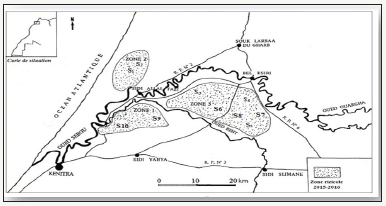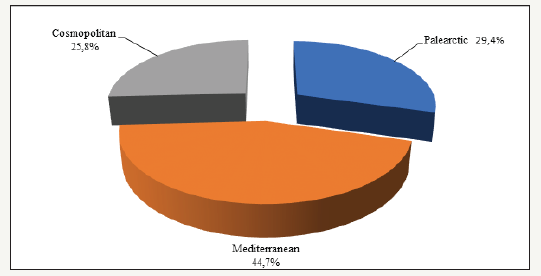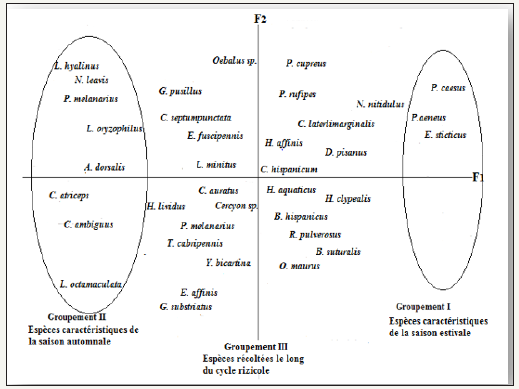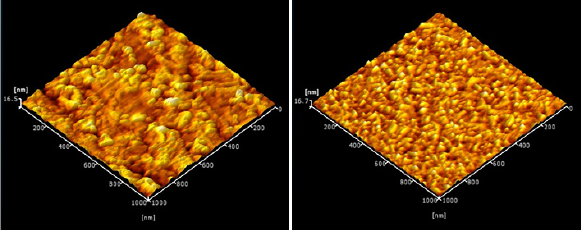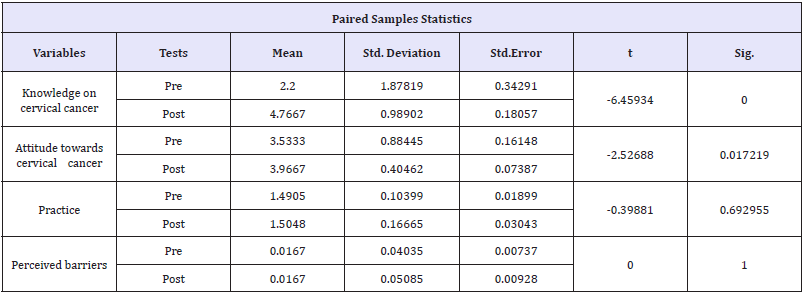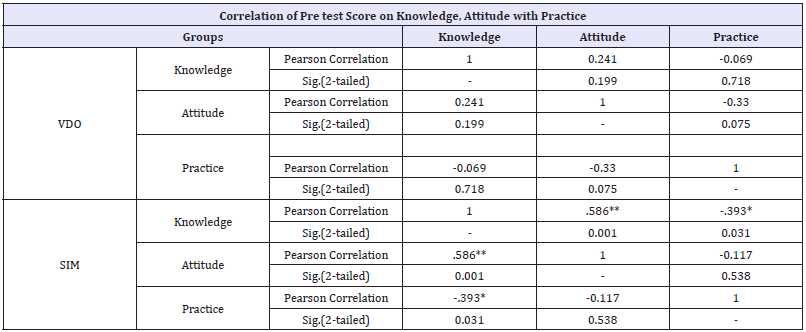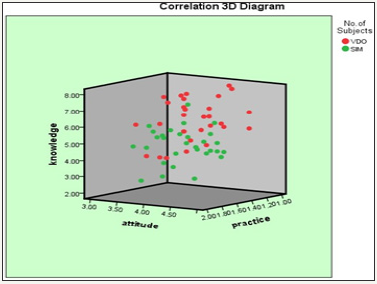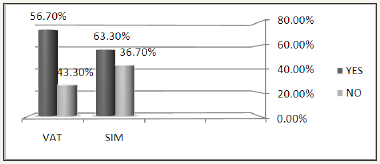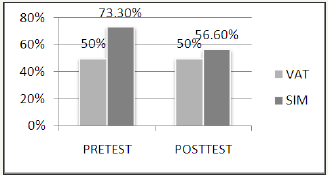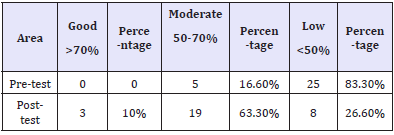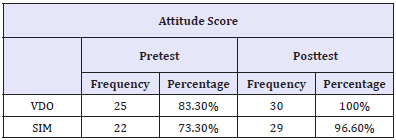Response of Soybean to Micronutrients,
Amino Acid and NPK Foliar Application
Under Normal and Drought Stress Condition by Ajam Norozei
H in Environmental Analysis & Ecology Studies_Crimson Publishers high impact Journals
Abstract
Soybean (Glycin max (L.) Merr), from the legume’s family has an important place among the industrial
plants in the world. It’s a summer plant and faced the heat and drought season During the growing
season, its greatly affect soybean yield. Drought stress is one of the most important environmental factors
in reducing the growth and yield of many crops, especially in arid and semi-arid regions of the world. The
foliar application of the nutrient elements increases the yield, quality, resistance to pests and diseases
and resistance to drought stress. A field experiments was carried out at the Agricultural Experimental
Station of the Agriculture Research Centre at Iraqi -mahallah during summer seasons of 2016 and 2017
to study the effect of foliar application of Ca Zn, B, N, P, k Amino acid and water on growth, yield and
quality of two soybean cultivars under normal and water stress conditions. Result showed the effect of
foliar application year on plant height, pod number per plant, seed number per pod and grain yield was
significant. the highest grain yield (4021.91kg ha-1) achieved B application in 2017.
The lowest grain yield (237.41kg ha-1) was obtain in 2016 and control treatment, also there was no
significant difference between control treatment and water application in two year of experiment. The
result showed in 2017 there was no significant difference in treatment in seed protein content. also, there
was no significant difference between foliar application and control in seed oil content in 2016. Also, two
cultivars have significant different in grain yield in 2017. But there was no significant difference in two
cultivars in 2016. In general, results showed that spray application of nutrients, especially B application,
improves the yield and yield component (number of pods, number of seed, 1000-seed weight and grain
yield) in normal and drought stress.
Keywords: Grain yield; Irrigation; Nutrition; Seed oil; Seed protein
Introduction
Drought stress is one of the most important environmental factors in reducing the growth
and yield of many crops, especially in arid and semi-arid regions of the world. Reduced
photosynthesis due to close the stomatal, decreasing plant growth, the lack of photosynthetic
materials necessary to fill grain and reduce the length of grain filling period is one of the most
important drought effects on plants. Drought reduced photosynthetic rate and metabolism
of carbohydrates in leaves, and these two processes reduce the amount of material available
for transfer to the storage plant’s organs, which can increase the abortion of the reproductive
organ. During drought stress, due to the increase in soluble concentrations in the root
environment and thus the increase of the soil osmotic potential, the absorption of nutrients
is greatly reduced.
When the soil pH is rising, the absorption of micronutrient elements is higher than other
elements Becomes disturbed. Soybean (Glycin max (L.) Merr), from
the legume’s family has an
important place among the industrial plants in the world. According to
the Bureau of Statistics
and Information of the Iran Agricultural Jahad Organization The total
area under cultivation
of soybeans in Iran during the 2011-2012 crop year was between 76
thousand hectares,
reaching 78 thousand hectares in 2015, that produced 190 thousand tons
grain from this
area. It’s a summer plant and faced the heat and drought season During
the growing season, its greatly affect soybean yield. Good and
Zaplachiniski (1994),
reported Accumulation of compounds such as proline and amino
acids in green tissues of rapeseed under drought stress conditions,
provide water absorption from the root environment for the plant.
But the plant’s reliance on these organic compounds is costly
to regulate osmotic and will reduce yield. Suitable Nutrition Under
conditions of stress, help plant to Tolerance Different stress [1]. The
results of various experiments show that the foliar application of
the elements increases the yield, Quality, resistance to pests and
diseases and resistance to drought stress. In soybeans, application
of Zn increased dry matter, number of pods, number of seeds
per pod and 100 seed weight. Zinc may also increase seed yield
by increasing the absorption of other nutrients such as nitrogen,
phosphorus and potassium. Positive effects of zinc have been
reported in the production of growth hormones (auxins) and
photosynthesis.
Bergland (2002) has reported that zinc spray application,
especially in vegetative growth stages, increases the yield of
soybeans. Researchers reported that biomass, grain yield and oil
content of sesamum indicum L. increased with the Boron foliar
application and on effect deficiency of boron, did not produce
any seeds in this plant. Riley et al. (2000) also reported increase
in oil and protein content of Wheat and canola seeds in using zinc
sulfate. Aghei Sarbarzeh (1995) investigating the relationship
between zinc and drought tolerance index in wheat showed that
Zinc application increased drought tolerance in bread wheat and
durum wheat cultivars. Marschner expressed Zinc is involved as a
cofactor in activating several enzymes. These enzymes play a role
in the metabolism of carbohydrates and proteins. Delaney et al.
Zinc and Mn, especially in drought-tolerant cultivars, play a role in
the osmotic regulation process with increased proline and soluble
sugars. Movahedi Dehnavi (2001) reported an increase in zinc
in the seed filling stage in Carthamus tinctorius L drought stress
conditions, also drought stress at the reproductive stage limits the
transfer of Fe and Mn to grain. The present study was conducted to
determine the effect of spraying various micronutrient on yield and
quality of soybean under drought stress conditions.
Material and Methods
The study was conducted at Agricultural Research Station of
Gorgan, Golestan province, Iran (5m a.s.l., 36 N, 54°E). Based on
Coupon classification the region could be classified as warm and
humid climate. Experiment was conducted during summer seasons
of 2016 and 2017 to study the effect of foliar application of Ca Zn,
B N, P, K Amino acid and water on growth, yield and quality of two
soybean cultivars under water stress conditions. Soil chemical and
mechanical characteristic are presented in Table 1. Characteristics
of the genotypes tested in this research presented in Table 2.
Also, the meteorological statistics of the test site during the two
cultivation years are presented in Table 3.
Table 1:Some of physicochemical characteristics of field soil.

Table 2:Characteristics of the genotypes tested in this research.

Table 3:Variation of temperature and rainfall in Hashemabad meteorology station during 2016-2017 growing seasons.
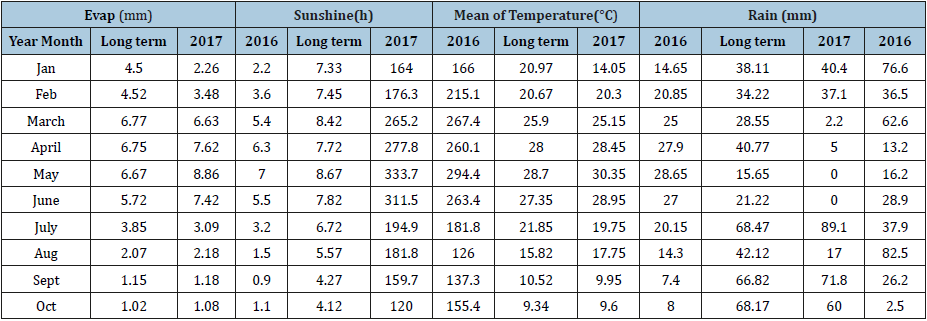
A factorial split-plot design in a randomized complete block
with three replicates was applied in two condition normal
(irrigation after 60mm Evaporation from the evaporation pan and
water stress (120mm Evaporation from the evaporation pan). The
main plots included: normal and drough stress condition. also, Ca
Zn B N, P, K. Water and control (no- spraying) and two soybean
genotypes (DPX and Amir) were located in subplots. Each subplots
size into main plot were 3.6×5m and consisted of six planting rows.
The distance between the blocks and the main plot was 2m, the
distance between the plants was 8cm, the distance between the
rows was 60cm. The cultivation was in joly of both years. for seed
emergence an Irrigation was Done after planting. To apply drought
stress, irrigation was continued when 120mm Evaporation from
the evaporation pan. Phonological stages were recorded during the
experiment with Fehr & Caviness (1977) method.
Foliar application of these treatments was used according to
the manufacturer’s recommendation during three stages of the
beginning of flowering (R1 stage), beginning of seed filling (R3
stage) and termination of seed filling (R5 stage). In each year after
harvesting maturity, sampling for measurement grain yield and yield
components from each experimental unit was performed taking
into account marginal effects. For Ca, Zn and B treatments were
used CaCl, ZnSO4 and H3BO3. Foliar application of these treatments
was used during two stages of the beginning of flowering (R1
stage), beginning of seed filling (R3 stage) and termination of seed
filling (R5 stage) according to the manufacturer’s recommendation.
The measurements included the final plant height, the height of
the first node from the soil surface, the number of nodes in the main
steam and the number of branches in 5 randomized plants. Also, the
yield components were including number of pods per plant, number
of pods per square meter, number of seeds per pod, weight of 100
seeds and grain yield (kg/ha). For estimation of total oil content,
10g of seeds were crushed and extracted with petroleum ether for
4h in a Soxhlet apparatus according to the method described by
AOAC. The extract was concentrated under reduced pressure. The
total seed oil content was calculated as percentage of sesame seeds
(Hussein et al. 2016). Oil yield was calculated by using grain yield ×
Oil percent (Malacrida et al. 2011). All of the data obtained for two
consecutive years were subjected to analysis of variance using SAS
software (Statistical Analysis Software, 9.1). Differences among the
treatments were assessed with the LSD (least significant difference)
only when the ANOVA F-test showed significance at P=0.05 and
Excel 2010 software was used for calculating and plotting charts.
Result and Discussion
Analysis variance of data showed that year had significant
effect on pod number per plant, number of seeds per pod, number
of seeds per plant, 100 seed weight and grain yield at p<0.1%. The
results showed Irrigation had significant effect on seed protein and
oil content. interaction effect of year × irrigation on seed number
per plant was significant but had no significant effect on seed oil
and protein percent. Also, interaction effect of irrigation × cultivar
and irrigation × cultivar × cultivar on any of the mentioned traits
was not significant. The results showed that interaction effect of
irrigation × foliar application on pod number per plant, 100 seed
weight, grain yield, seed protein and oil content was significant.
The result showed that there was no significant difference in terms
of number of pods per plant, number of seeds per pod, number of
seeds per plant and percentage of protein content in the studied
varieties.
However, there was a significant difference in seed oil content,
grain yield and 100-seed weight in the studied varieties. The foliar
application effect on seed yield and yield components and seed oil
and protein content was significant. the interaction effect of year
× foliar application on number of pods per plant, number of seeds
per pod, number of seeds per plant, 100 seed weight and seed yield
were significant. The results showed that the interaction effect of
spray × cultivars on seed oil and protein content was significant.
Also, interaction effect of year × foliar application× cultivar and
year × irrigation × foliar application × cultivar on any of the traits
was not significant.
Interaction effect of year × irrigation
The results showed that there was no significant difference in
plant height between normal moisture condition and drought stress
in the first year of experiment (2016). but, the number of seeds per
plant and grain yield were significantly different (Table 4). In the
first year of experiment (2016), the highest number of seeds per
plant and grain yield were 49.55 and 1428.33 (kg ha-1) in normal
moisture conditions (Table 4). In the second year of experiment
(2017), there was a significant difference in plant height and
number of seeds per plant between normal condition and drought
stress. The highest plant height (66.57cm) and number of seeds per
plant (178.23) was obtained in Normal condition.
Table 4:Mean comparisons of year and irrigation on soybean traits.

Note: Any two means sharing a common letter do not differ significantly from each other at 5%.
However, there was no significant difference in grain yield
between two moisture conditions (Table 4). Karami et al. (2011)
in their study on the effect of Zinc element irrigation on yield and
yield components of soybean in water stress conditions reported
that Zinc sulfate application increased yield and yield components.
They reported application of zinc coatings could reduce the
effects of water stress and improve the growth conditions for the
plant. Goodarzi et al. (2013), in study of the effect of different
concentrations of Iron and Zinc on the Zea maiz .L, reported that the
interaction effect of Iron 2mg.L-1 and Zinc 8mg.L-1 was significant
and the highest 1000-seed weight, seed number per row, row
number per corn, biological yield, grain yield, harvest index and
yield of seed oil were obtained in interaction effect of Iron 2 mg.L-1
and Zinc 8mg.L-1.
Interaction of foliar application × irrigation
The results of the means comparison in (Table 5) showed that
in the normal conditions, the highest plant height was 81.66cm and
obtained in the amino acid foliar application treatment. However,
there was no significant difference in plant height between Zn and
Amino acid treatment. Also, there was no significant difference in
treatments of Ca and N.P.K foliar application in plant height and the
lowest plant height (46cm) was obtained in control treatment. Also,
in normal conditions the number of stem nodes in Ca, Zn, B, N.P.K
and amino acids was in a group and the lowest number of stem
node was 2.7 and obtained in control treatment (Table 5).
The highest pod number per plant was 77.41 and observed in
N.P.K treatment. However, Zn, B, N.P.K and amino acid were grouped
into a common statistical group (Table 5). The lowest pod number
per plant was 35.58 and obtained in control treatment. In the normal
conditions, the highest 100- seed weight was obtained in B foliar
application, and other treatments have not significant difference.
also, the highest grain yield was 3631.25kg/ha and obtained in and
in B spray application. The lowest grain yield was 1115.25kg ha-1
and observed in control treatment and no significant difference
was observed in water foliar application and control. our results
showed, in the normal conditions, the highest seed protein was
obtained in water application. And was no significant difference in
other treatment in seed protein. The highest oil seed was obtained
in the control treatment. However, the water foliar application and
control have not significant difference (Table 5) in drought stress
conditions Different results were obtained.
The results showed that under drought stress conditions, none
of the treatments had significant effect on plant height, number of
nodes on main stem and 100 -seed weight. The highest number
of pods per plant was 61 and obtained in B foliar application.
But there was no significant difference between Ca, Zn, B, N.P.K
and Amino acid treatment. The lowest number of pods per plant
(40.33) observed in water foliar application and there was no
significant difference with control treatment results showed that
in drought stress conditions, the highest grain yield was obtained
in B application (2753.83kg ha-1). Also, there was no significant
difference in Ca, Zn, N.P.K and amino acids treatments. The lowest
grain yield was 1295.66kg ha-1 and obtained in control treatment
(Table 5). Results showed, in drought stress conditions, none of the
foliar application treatments had a significant effect on oil seed and
protein content (Table 5).
Table 5:Mean comparisons of irrigation and foliar application on soybean traits.

Note: Any two means sharing a common letter do not differ significantly from each other at 5%.
Interaction of Year × cultivar
The results showed that the interaction of year × cultivar on
the number of stem node and grain yield was significant. in the first
year of the experiment (2016), the highest number of stem nodes
was 3.15 and in the Amir cultivar. However, in the second year of
experiment, two cultivars did not differ significantly in terms of
number of stem node (Table 6). Also, in the first year of experiment,
there was no significant difference in cultivar grain yield. But in
2017, the highest grain yield was 3178.52kg/ha and in the Katoul
cultivar (Table 6).
Table 6: Mean comparisons of year and cultivar on soybean traits.

Note: Any two means sharing a common letter do not differ significantly from each other at 5%.
Interaction of the year x foliar application
Analysis of variance showed that the interaction of year × foliar
application was significant on plant height, number of pods per
plant, number of seeds per pod, number of seeds per plant and
grain yield (Table 7). In the first year of experiment (2016), the
highest plant height was 81.66cm and was obtained in the amino
acid foliar application. Also, there was no significant difference
between and amino acid and Zn treatments in plant height. Result
showed Ca, B and N.P.K treatments were classified in a common
statistical group for plant height. The lowest plant height was
46cm and was obtained in control treatment. Also, there was no
significant difference between water foliar application and control
treatments. In the second year of experiment (2017), there was no
significant difference between treatments in plant height (Table 7).
In the first year of experiment, the highest number of pods per
plant was 54.16 and obtained in N.P.K application. However, NPK
and amino acid foliar application have not significant difference in
number of pods per plant. The lowest number of pods per plant was
17.08 and obtained in the control. But in 2017, the highest number
of pods per plant was 93 and obtained in B application. Also, Ca,
Zn, N.P.K and amino acids have not significant difference. The
lowest number of pods per plant was 60.08 and observed in control
treatment. However, there was no significant difference between
control treatment and water application (Table 7).
In the first year of the experiment, there was no significant
difference between Ca, Zn, B, N.P.K and amino acids in seed
number per pod. Also, water application and control treatment had
lowest number of seed per pod. In the second year of experiment
(2017), the highest number of seeds per pod (2.60) was obtained
in B application. Also, the lowest number of seeds per pod (1.69)
obtained in control treatments that have not significant difference
with water application treatments. The number of seeds per plant
was also similar to the number of seeds per pod (Table 7). The
results showed that in the first year of experiment, the highest
grain yield was 2363.16kg. ha-1 and was obtained in B treatment.
Also, there was no significant difference in Ca, Zn, N.P.K and amino
acids in grain yield.
The lowest grain yield was observed in control treatment
and was not significant difference between control and water
application (Table7). In the second year of experiment (2017),
the highest grain yield was 4021.91kg ha-1 and observed in B
application. Also, the lowest grain yield was 2173.50kg. ha-1 and
obtained in control treatment. Hosseinpour et al. (2011), showed
that Amino acid foliar application increase grain yield, protein and
oil content significantly (Table 7).
Table 7:Mean comparisons of year and foliar application on soybean traits.
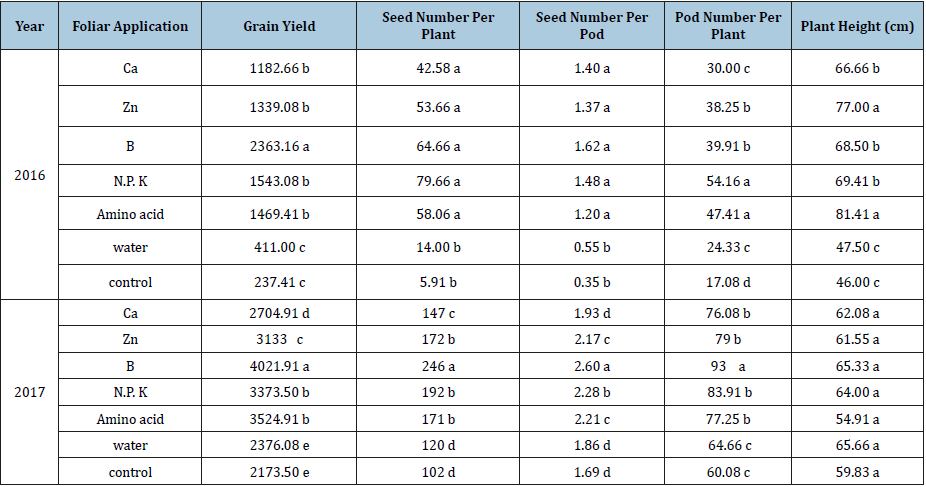
Note: Any two means sharing a common letter do not differ significantly from each other at 5%.
Interaction of the cultivar × foliar application
Our results showed that interaction of cultivar × foliar
application on plant height, seed oil and protein content was
significant. According to the results in Katol cultivar, there was
no difference between treatments in plant height and seed oil.
the lowest protein content was 20.17% and observed in Ca foliar
application, but there was no significant difference in treatment
and control (Table 8). But in the Amir cultivar, Ca, Zn, B, N, P, K and
amino acids have not significant difference in plant height. Also,
control and water application treatment have the lowest plant
height. The results showed, in Amir cultivar, there was no significant
difference in protein percentage between treatments. But the
highest percentage of seed oil was observed in control treatment,
there was no significant difference in water application and control.
Also, Ca, Zn, B, N, P, K and amino acids have not significant difference
seed oil (Table 8).
Table 8:Mean comparisons of cultivar and foliar application on soybean traits.
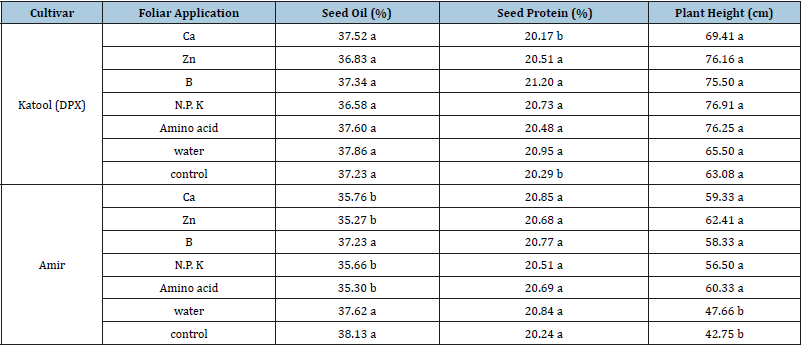
Note: Any two means sharing a common letter do not differ significantly from each other at 5%.
Most plants can usually tolerate mild stresses and their growth
is not reduced. But when the drought stress is severe Due to the
decrease in cellular inflammation, cell growth and division, and
eventually plant growth, are greatly reduced. Rahimizadeh et al.
(2012) reported that drought stress had a significant effect on plant
height in sunflower, lowest plant height was observed in severe
drought stress treatment (25% less than non-stress treatment).
Imam and Rabbani (2011) also found that drought stress in
vegetative stage reduced plant height significantly (10.2%) in
Maize. Soy (glycine max l) The most important oily plants and
has the highest cultivation area in the world among oily plants
[2]. In About 1/3 of the world’s cultivated lands, drought stress is
major factor in reducing crop yield [3]. Under drought stress due
to osmotic potential loss, nutrient availability is one of the most
influential factors in plant growth and development.
On the other hand, most of the agricultural soils of Iran are facing
low pH, leading to low nutrients solubility. Under such a condition,
application of fertilizers may result in increased nutrients solubility
[4]. Drought stress reduces biomass, grain yield, plant height and
number of branches in soybeans [5]. Drought stress during plant
growth period reduced plant height, number of nodes, branch
number, plant weight, seed number, seed weight, pod number, pod
weight and soybean harvest index [6]. the study of the effect of two
levels of irrigation on two soybean cultivars (one narrow growth
and unlimited growth) showed that drought stress at the seed filling
stage reduced grain weight. The effective grain filling period
was not affected by the stress in the non- determinate cultivar, but
this period was reduced in determinate cultivar.
The stress is one of the main factors affecting seed composition,
protein content, grain yield and finally the quality of crops
decrease the rate of carbon dioxide metabolism, reduce stomatal
conductance and decrease water use efficiency, the factors involved
in the reducing crop yields under drough stress conditions [7].
Hemmati et al. (2018) reported that Under drought stress, reactive
oxygen species (ROS) are produced due to an imbalance between
light interception and its use and ROS, causing damage to a plant.
Bilaloy et al. (2013) also reported seed oil content of soybean under
drought stress showed a significant decrease. The reason is the
high sensitivity of lipid accumulation to drought stress at the seed
filling stage. Kandogan et al. (2013) in their research on soybeans,
reported that different levels of drought stress increased seed
protein content and the lowest percentage of protein was obtained
in control treatment (complete irrigation).
Drought stress in flowering stage delayed flowers formation,
also increase percentage of infertile flowers, falling flowers and
pods Therefore, these problems can reduce the number of pods in
drought stress conditions [8]. Usually in soils where pH, chemical
composition of food and root growth conditions and intake
of nutrient element is unsuitable, crop is encountered with a
nutritional disorder. Under drought stress conditions, due to lower
soil soluble content, the crop faces nutrient element deficiency.
Therefore, in this condition, nutrient foliar application is the best
way to crop nutrition [9]. The nutrients can be applied to crop in a
variety of ways like seed treatment, soil and foliar application [10].
Foliar application of micronutrients improves the nutrition
[11]. Zhang et al. [12,13] reported foliar Zn application, foliar N,
P, and K fertilization has been used to increase crop production,
especially in dryland areas. The limited translocation of Zn in
woody species can result in highly non-uniform Zn distribution and
the occurrences of the characteristic symptoms of Zn deficiency in
fruit/nut trees which includes poor apical meristem development,
resetting and tufting of newly emerged leaves [14]. The use of
macro- and micro- nutrients is one of the strategies for coping with
environmental stresses [15]. Kumar-Pal et al. [16] observed that
application of B, Se, and Fe, which may be attributed to increased
levels of photosynthetic pigments (2013).
In fact, spraying causes the nutrients reach the crop during
critical stages of growth, and when the plant needs nutrient
more [17]. Oilseed crop such as soybeans are more susceptible to
micronutrient deficiency, especially B, Zn and iron in comparison
with cereals. However, the effects of foliar applications of Zn and
Fe on rice growth could be related to the initial Zn and Fe supply
[12,18]. It has recently been reported that the foliar application
of Zn-amino acids chelates (ZnAACs) can improve the nutritional
quality of wheat and is more effective than ZnSO4 in increasing
grain Zn, Fe, and protein concentrations and Zn bioavailability
[19]. The Zn concentrations of grain milling fractions are also
improved by foliar Zn applications. Additionally, the increase in
the Zn concentrations of grain and grain milling fractions due to
foliar fertilization is enhanced by increased soil N levels in both
fields and green-houses (Cakmak et al., 2010; Kunman et al., 2011)
improvements in rice yield after lime or foliar application of Zn or
Fe have also been reported [18,20].
Salama et al. [21] reported Zn is a cofactor of carbonic
anhydrase that increases the content of CO2 in the chloroplast,
and thus also increases the carboxylation capability of the Rubisco
enzyme. Kader et al. [22] reported that Zn has an important role
in biological activity, such as enzymatic activity, chlorophyll
synthesis and nutrient absorption from root. also, Researchers
have shown that Zn and Ca foliar application have a positive effect
on crop growth under environmental stress conditions [23]. Brand
& Heinickle [24] obtained the ZnSO4 had a positive effect on total
carbohydrate content that may be due to its important role in
carbohydrate metabolism enzymes. also, Zn is a vital nutrient for
the plants and its role as a structural constituent or regulatory
co-factor in wide range of different enzymes [1]. This support late
season foliar application of macro and micronutrients (N, B and Zn)
can enhance concentration of carbohydrates and mineral nutrients
reserves [25-30].
Conclusion
The results showed that drought stress reduce soybean yield
and yield components, which depends on the severity of the stress.
The weather conditions can also be effective. in the year with less
rainfall, the effect of drought stress was higher. In these conditions,
the nutrient foliar application played a more effective role in
preventing the loss of soybean yield. Also, results showed that
spray application of nutrients, especially B, improves the yielding
traits (number of capsules, number of seed, 100-seed weight, grain
yield and biological yield) and protein content of the seed under
drought stress conditions in each two years of experiment. But the
foliar application of nutrient did not have a significant effect on the
seed oil content. Between the genotype examined, DPX genotype
showed a significant difference in yield and yield component in
compared to Amir genotype in normal and drought.
References
- Alloway BJ (2008) Zinc in soils and crop nutrition. IZA, IFA (2nd edn), Brussels, France.
- Grieshop
CM, Fahey GC (2001) Comparison of quality characteristics of soybeans
from Brazil, China, and the United States. Agriculture Food Chemical
49(5): 2669-2673.
- Clover G, Smith H, Jaggard K (1998) The crop under stress. British Sugar Beet Review 66(3): 17-19.
- Farahani
S, Aghighi Shahverdi M (2015) Evaluation of the effect of Nano-iron
fertilizer in compare to iron chelate fertilizer on qualitative and
quantitative yield of saffron. Agricultural Crop Management 17(1):
155-168.
- Mirakhori
M, Paknejad F, Moradi F, Ardakani M, Zahedi, et al. (2009) Effect of
drought stress and methanol on yield and yield components of soybean
max. American Journal of Biochemistry and Biotechnology 5(4): 162-169.
- Shahmoradi SH (2003) Effects of drought stress on
qualitative and quantitative traits in soybean cultivars and advanced
lines. Faculty of Agriculture Tehran University, Iran.
- Gonzalez
AM, Martı́n Olivera A, Morales MSJ (2005) Physiological responses of
tagasaste to a progressive drought in its native environment on the
Canary Islands. Environment Experiment Botany 53(2): 195-204.
- Mahlooji
M, Mousavi SF, Karimi M (2000) The effects of water stress and planting
date on yield and yield components of pinto bean (phaseolus vulgaris). Journal of Water and Soil Science 4(1): 57-68.
- Gooding MJ, WP Davies (1992) Foliar urea fertilization of cereals. Fertilizer Research 32(2): 209-222.
- Rehim A, Farooq M, Ahmad F, Hussain M (2012) Band
placement of phosphorus improves the phosphorus use efficiency and wheat
productivity under different irrigation regimes. International Journal
of Agriculture and Biology 14(5): 727-733.
- Arif M, Chohan MA, Ali S, Khan S (2006) Response of wheat to foliar application of nutrients. J Agric Biol Sci 1(4): 30-34.
- Wei
Y, Shohag MI, Yang X, Zhang Y (2012) Effects of foliar iron application
on iron concentration in polished rice grain and its bioavailability. J
Agric Food Chem 60(45): 11433-11439.
- Zhang YQ, Sun YX, Ye YL, Karim MR, Xue YF (2012) Zinc
biofortification of wheat through fertilizer applications in different
locations of China. Field Crops Res 125: 1-7.
- Swietlik D, Faust M (1984) Foliar nutrition of fruit crops. horticultural reviews 6: 287-355.
- Shahzadi
I, Iqbal M, Rasheed R, Ashraf MA, Perveen S, et al. (2017) Foliar
application of selenium increases fertility and grain yield in bread
wheat under contrasting water availability regimes. Acta Physiologiae
Plantarum 39: 173.
- Kumar
Pal P, Prasad R, Pathania V (2013) Effect of decapitation and nutrient
applications on shoot branching, yield, and accumulation of secondary
metabolites in leaves of stevia Rebaudiana Bertoni. J Plant Physiol 170(17): 1526-1535.
- Shorrocks VM (1997) The occurrence and correction of boron deficiency. Plant and Soil 193: 121-148.
- Guo
F, Ding C, Zhou Z, Huang G, Wang X, et al. (2018) Effects of combined
amendments on crop yield and cadmium uptake in two cadmium contaminated
soils under rice-wheat rotation. Ecotoxicol Environ Saf 148: 303-310.
- Ghasemi
S, Khoshgoftarmanesh AH, Afyuni M, Hadadzadeh H (2013) The
effectiveness of foliar applications of synthesized zinc amino acid
chelates in comparison with zinc sulfate to increase yield and grain
nutritional quality of wheat. European Journal of Agronomy 45: 68-74.
- Zhu
QH, Huang DY, Zhu GX, Ge TD, Liu GS (2010) Sepiolite is recommended for
the remediation of Cd-contaminated paddy soil. Acta Agriculturae
Scandinavica 60(2): 110-116.
- Salama
ZA, Fouly MM, Lazova G, Popova LP (2006) Carboxylating enzymes and
carbonic anhydrase functions were suppressed by zinc deficiency in maize
and chickpea plants. Acta Physiologiae Plantarum 28(5): 445-451.
- Kader
A, Mona, G (2013) Effect of sulfur application and foliar spraying with
zinc and boron on yield, yield components, and seed quality of peanut (Arachis hypogaea L.). Research Journal of Agriculture and Biological Sciences 9(4): 127-135.
- Chengbin X, Xuemei L, Lihong ZH (2013) The effect of calcium chloride on growth, photosynthesis, and antioxidant responses of Zoysia japonica under drought conditions. Plos One 8(7): 68214.
- Brand IA, Heinickle A (1991) Key enzymes of carbohydrate metabolism as targets of the 11.5kDaZn2+-binding protein (parathymosin). J Biol Chem 266(31): 20984-20989.
- Keshavarz
K, Vahdati K, Samar M, Azadegan B, Brown PH, et al. (2011) Foliar
application of zinc and boron improves walnut vegetative and
reproductive growth. Hort Technology 21(2): 181-186.
- Ball
RA, Purcell LC, Vories D (2000) Short-season soybean yield compensation
in response to population and water regime. Crop Science 40(4):
1070-1078.
- Bellaloui
N, Mengistu A, Kassem A (2013) Effects of genetics and environment on
fatty acid stability in soybean seed. Food and Nutrition Sciences 4:
165-175.
- Candogana
B, Sincikb M, Buyukcangaza H, Demirtasa C, Goksoyb AT, et al. (2013)
Yield, quality and crop water stress index relationships for deficit
irrigated soybean Glycine max (L.) Merr. in sub humid climatic conditions. Agricultural Water Management 118: 113-121.
- Kadkhodaei A, Razmjoo J, Zahedi M, Pessarakli M (2014) Oil content and composition of sesame (Sesamum indicum ) genotypes as affected by irrigation regimes. Journal of the American Oil Chemists Society 9(10): 1737-1744.
- Leport
L, Turner NC, French RJ, Tennant D, Thomson BD, et al. (1998) Water
relation, gas exchange, and growth of cool-season grain legumes in a
Mediterranean type environment. European Journal Agronomy 9(4): 295-303.
For more articles in Crimson Publishers high impact Journals


